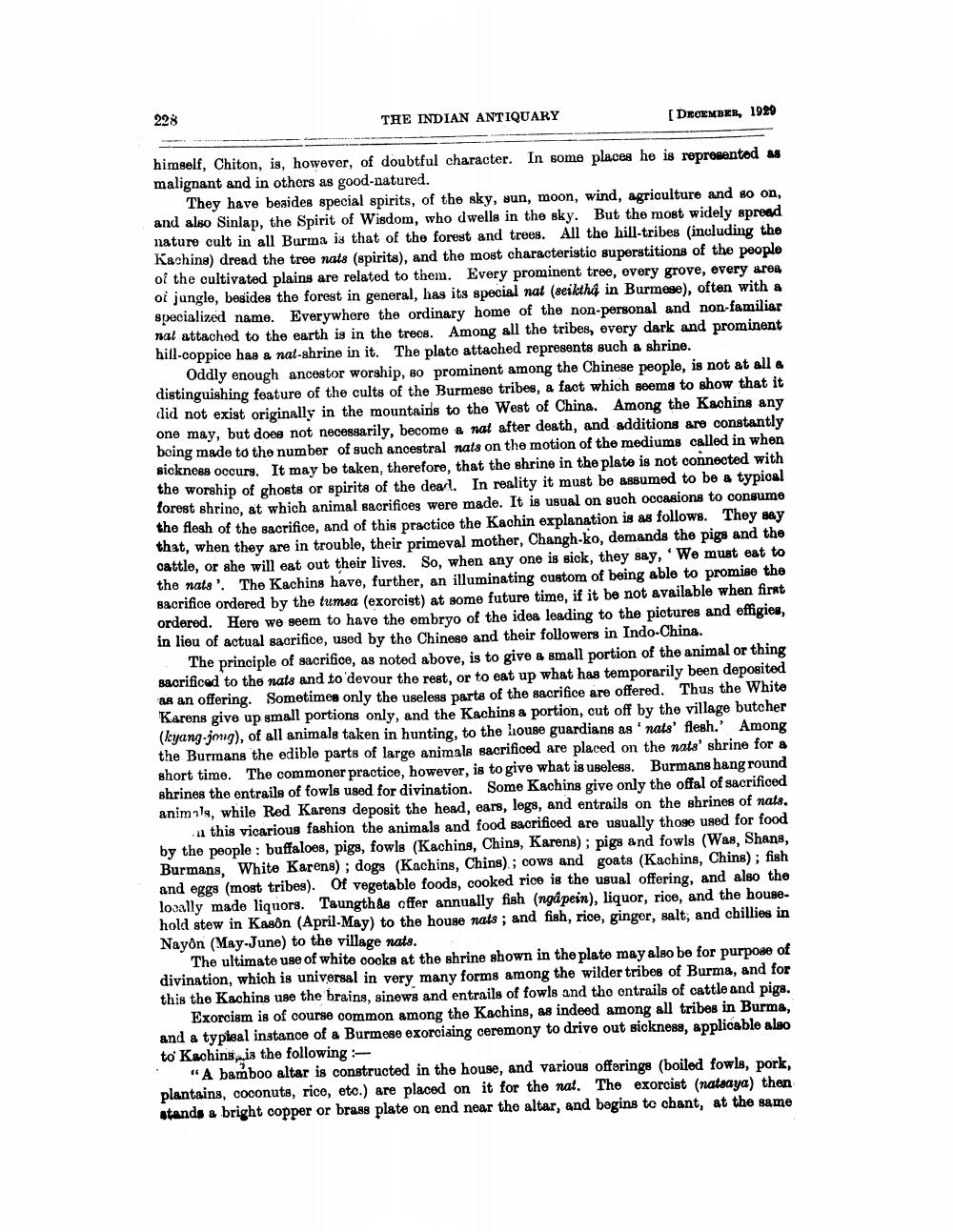________________
228
THE INDIAN ANTIQUARY
[ DECEMBER, 1929
himself, Chiton, is, however, of doubtful character. In some places he is represented as malignant and in others as good-natured.
They have besides special spirits, of the sky, sun, moon, wind, agriculture and so on, and also Sinlap, the Spirit of Wisdom, who dwells in the sky. But the most widely spread nature cult in all Burma is that of the forest and trees. All the hill-tribes (including the Kaching) dread the tree nats (spirits), and the most characteristic superstitions of the people of the cultivated plains are related to them. Every prominent tree, overy grove, every area oi jungle, besides the forest in general, has its special nat (seiktha in Burmese), often with a specialized name. Everywhere the ordinary home of the non-personal and non-familiar nal attached to the earth is in the trees. Among all the tribes, every dark and prominent hill-coppice has a nal-shrine in it. The plato attached represents such a shrine.
Oddly enough ancestor worship, 80 prominent among the Chinese people, is not at all & distinguishing feature of the cults of the Burmese tribes, a fact which seems to show that it did not exist originally in the mountains to the West of China. Among the Kaching any one may, but does not necessarily, become a nat after death, and additions are constantly being made to the number of such ancestral nats on the motion of the mediums called in when sickness occurs. It may be taken, therefore, that the shrine in the plate is not connected with the worship of ghosts or spirite of the dearl. In reality it must be assumed to be a typical forest shrino, at which animal sacrifices were made. It is usual on such occasions to consume the flesh of the sacrifice, and of this practice the Kachin explanation is as follows. They say that, when they are in trouble, their primeval mother, Changh-ko, demands the pigs and the cattle, or she will eat out their lives. So, when any one is sick, they say, 'We must eat to the nats'. The Kachins have, further, an illuminating custom of being able to promise the sacrifice ordered by the tumsa (exorcist) at some future time, if it be not available when first ordered. Here we seem to have the embryo of the idea leading to the pictures and effigies, in lieu of actual sacrifice, used by the Chinese and their followers in Indo-China.
The principle of sacrifice, as noted above, is to give a small portion of the animal or thing sacrificed to the nats and to devour the rest, or to eat up what has temporarily been deposited as an offering. Sometimes only the useless parts of the sacrifice are offered. Thus the White Karens give up small portions only, and the Kachins a portion, cut off by the village butcher (kyang-jong), of all animals taken in hunting, to the house guardians as 'nats' flesh. Among the Burmans the edible parts of large animals sacrificed are placed on the nats' shrine for a short time. The commoner practice, however, is to give what is useless. Burmans hang round shrines the entrails of fowls used for divination. Some Kachins give only the offal of sacrificed animals, while Red Karens deposit the head, ears, legs, and entrails on the shrines of nats.
a this vicarious fashion the animals and food sacrificed are usually those used for food by the people : buffaloes, pigs, fowls (Kaching, Chins, Karens); pigs and fowls (Was, Shans, Burmans, White Karens) ; dogs (Kaching, Chins); cows and goats (Kachins, Chins) ; fish and eggs (most tribes). Of vegetable foods, cooked rice is the usual offering, and also the loually made liquors. Taungths offer annually fish (nga pein), liquor, rice, and the household stew in Kasôn (April-May) to the house nats; and fish, rice, ginger, salt, and chillies in Nayôn (May-June) to the village nats.
The ultimate use of white cocks at the shrine shown in the plate may also be for purpose of divination, which is universal in very many forms among the wilder tribes of Burma, and for this the Kachins use the brains, sinews and entrails of fowls and tho ontrails of cattle and pigs.
Exorcism is of course common among the Kachins, as indeed among all tribes in Burma, and a typieal instance of a Burmese exorcising ceremony to drive out sickness, applicable alao to' Kachins is the following -
"A bamboo altar is constructed in the house, and various offeringe (boiled fowls, pork, plantains, coconuts, rice, etc.) are placed on it for the nat. The exorcist (natsaya) then stands a bright copper or brass plate on end near the altar, and begins to chant, at the same




